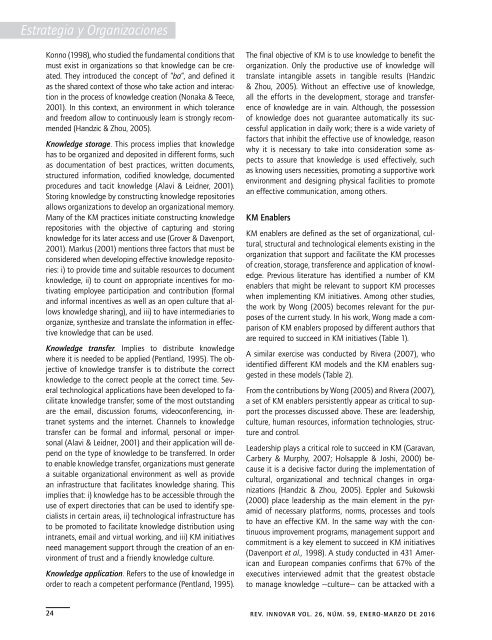Enero-marzo
v26n59
v26n59
You also want an ePaper? Increase the reach of your titles
YUMPU automatically turns print PDFs into web optimized ePapers that Google loves.
Estrategia y Organizaciones<br />
Konno (1998), who studied the fundamental conditions that<br />
must exist in organizations so that knowledge can be created.<br />
They introduced the concept of “ba”, and defined it<br />
as the shared context of those who take action and interaction<br />
in the process of knowledge creation (Nonaka & Teece,<br />
2001). In this context, an environment in which tolerance<br />
and freedom allow to continuously learn is strongly recommended<br />
(Handzic & Zhou, 2005).<br />
Knowledge storage. This process implies that knowledge<br />
has to be organized and deposited in different forms, such<br />
as documentation of best practices, written documents,<br />
structured information, codified knowledge, documented<br />
procedures and tacit knowledge (Alavi & Leidner, 2001).<br />
Storing knowledge by constructing knowledge repositories<br />
allows organizations to develop an organizational memory.<br />
Many of the KM practices initiate constructing knowledge<br />
repositories with the objective of capturing and storing<br />
knowledge for its later access and use (Grover & Davenport,<br />
2001). Markus (2001) mentions three factors that must be<br />
considered when developing effective knowledge repositories:<br />
i) to provide time and suitable resources to document<br />
knowledge, ii) to count on appropriate incentives for motivating<br />
employee participation and contribution (formal<br />
and informal incentives as well as an open culture that allows<br />
knowledge sharing), and iii) to have intermediaries to<br />
organize, synthesize and translate the information in effective<br />
knowledge that can be used.<br />
Knowledge transfer. Implies to distribute knowledge<br />
where it is needed to be applied (Pentland, 1995). The objective<br />
of knowledge transfer is to distribute the correct<br />
knowledge to the correct people at the correct time. Several<br />
technological applications have been developed to facilitate<br />
knowledge transfer; some of the most outstanding<br />
are the email, discussion forums, videoconferencing, intranet<br />
systems and the internet. Channels to knowledge<br />
transfer can be formal and informal, personal or impersonal<br />
(Alavi & Leidner, 2001) and their application will depend<br />
on the type of knowledge to be transferred. In order<br />
to enable knowledge transfer, organizations must generate<br />
a suitable organizational environment as well as provide<br />
an infrastructure that facilitates knowledge sharing. This<br />
implies that: i) knowledge has to be accessible through the<br />
use of expert directories that can be used to identify specialists<br />
in certain areas, ii) technological infrastructure has<br />
to be promoted to facilitate knowledge distribution using<br />
intranets, email and virtual working, and iii) KM initiatives<br />
need management support through the creation of an environment<br />
of trust and a friendly knowledge culture.<br />
Knowledge application. Refers to the use of knowledge in<br />
order to reach a competent performance (Pentland, 1995).<br />
The final objective of KM is to use knowledge to benefit the<br />
organization. Only the productive use of knowledge will<br />
translate intangible assets in tangible results (Handzic<br />
& Zhou, 2005). Without an effective use of knowledge,<br />
all the efforts in the development, storage and transference<br />
of knowledge are in vain. Although, the possession<br />
of knowledge does not guarantee automatically its successful<br />
application in daily work; there is a wide variety of<br />
factors that inhibit the effective use of knowledge, reason<br />
why it is necessary to take into consideration some aspects<br />
to assure that knowledge is used effectively, such<br />
as knowing users necessities, promoting a supportive work<br />
environment and designing physical facilities to promote<br />
an effective communication, among others.<br />
KM Enablers<br />
KM enablers are defined as the set of organizational, cultural,<br />
structural and technological elements existing in the<br />
organization that support and facilitate the KM processes<br />
of creation, storage, transference and application of knowledge.<br />
Previous literature has identified a number of KM<br />
enablers that might be relevant to support KM processes<br />
when implementing KM initiatives. Among other studies,<br />
the work by Wong (2005) becomes relevant for the purposes<br />
of the current study. In his work, Wong made a comparison<br />
of KM enablers proposed by different authors that<br />
are required to succeed in KM initiatives (Table 1).<br />
A similar exercise was conducted by Rivera (2007), who<br />
identified different KM models and the KM enablers suggested<br />
in these models (Table 2).<br />
From the contributions by Wong (2005) and Rivera (2007),<br />
a set of KM enablers persistently appear as critical to support<br />
the processes discussed above. These are: leadership,<br />
culture, human resources, information technologies, structure<br />
and control.<br />
Leadership plays a critical role to succeed in KM (Garavan,<br />
Carbery & Murphy, 2007; Holsapple & Joshi, 2000) because<br />
it is a decisive factor during the implementation of<br />
cultural, organizational and technical changes in organizations<br />
(Handzic & Zhou, 2005). Eppler and Sukowski<br />
(2000) place leadership as the main element in the pyramid<br />
of necessary platforms, norms, processes and tools<br />
to have an effective KM. In the same way with the continuous<br />
improvement programs, management support and<br />
commitment is a key element to succeed in KM initiatives<br />
(Davenport et al., 1998). A study conducted in 431 American<br />
and European companies confirms that 67% of the<br />
executives interviewed admit that the greatest obstacle<br />
to manage knowledge —culture— can be attacked with a<br />
24 REV. INNOVAR VOL. 26, NÚM. 59, ENERO-MARZO DE 2016


